No products in the cart.
Linh Nga Magazine, News
9 Popular Korean Wedding Traditions You Need to Know
Korean Wedding Traditions is one of many beautiful wedding customs of Korea that may interest you. For example, purchasing a special pillow for the bride to rest her head at the wedding.
A traditional yet colorful celebration, a wedding in Korea. Even while Western practices have increasingly influenced Korean weddings in recent years, most ceremonies still include a number of Korean Wedding Traditions. You will very surely see symbolic ceremonies, gift-giving, bowing, and vows during a Korean wedding.
Some of the most well-known Korean Wedding Traditions are covered in more detail below.
01 Korean Wedding Tradition style Hanbok
The groom may dress in hanbok or a suit, while the bride is more likely to wear the traditional Korean attire known as hanbok, which was previously made of silk. A bride may decide to wear a wonsam, an elaborate top garment embroidered with motifs in silk thread, combined with a voluminous skirt known as a chima during the paebaek and the formal Korean wedding tradition. The jeogori, a long-sleeved outer garment often shorter and cut higher than the wonsam, is worn by a less formal but traditional bride.


The Chosun Dynasty’s court clothing, the samogwandae, is worn by the more formal groom or by a groom attending a paebaek. His clothing consists of a long, ornate vestment that resembles a robe on top of leggings, a jacket, a belt, and a samo, a black cap with wings on the sides. The less formal groom could choose to merely don baji (pants) and a jeogori (jacket) for his outfit.
02 Korean Wedding Tradition style Specific Colors
The colors worn by the bride and groom represent the “eum-yang,” or “taeguk,” in Korean culture (also known as yin and yang). The groom wears a blue hanbok, while the bride dons a red one; combined, these two hues, like the circle in the middle of the Korean flag, symbolize the harmony of several complementing forces. The marriage would often take place around dusk, signifying the harmony of light and dark. While the mother of the groom usually wears cold tones like blue, gray, or green, the mother of the bride will often wear warm tones like pink, purple, or orange. However, moms with particular color preferences have been known to switch tones.


03 Korean Wedding Tradition style Envelopes of Money
At a Korean wedding, cash gifts in white envelopes are the most typical presents. The bride and groom customarily get blessings from the parents as well as financial presents at the paebaek. In order for visitors to deposit their white envelopes holding their presents, LeeHwa Wedding supplies silk bags. The bride’s family also sends financial presents to the groom’s family before the wedding.
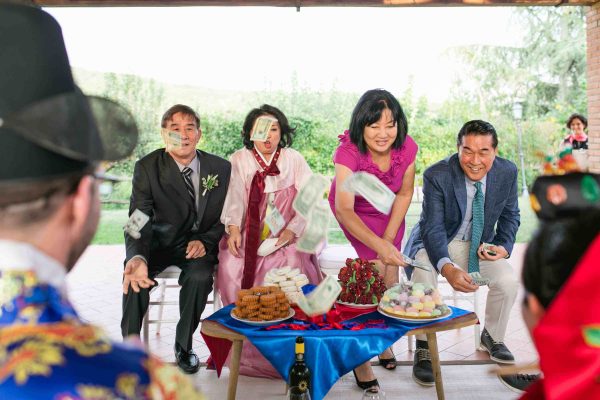

04 Korean Wedding Tradition style Processional Parade
The music will be traditional Korean music. Traditionally, the groom would ride up to the bride’s house in a procession, but nowadays, the officiant will enter and start by explaining the wedding, taking the crowd through its many stages. First to enter will be the two moms carrying their candles. Mothers of the bride and groom each carry red and blue candles, respectively. These two hues symbolise the harmony of cosmic forces in nature, just like the red and blue attire. They burn one candle, signifying the start of the Korean wedding tradition, when the mother concludes the procession.


05 Korean Wedding Tradition style Explanation of the Table
The officiant then describes the items on the table, including pinecones, bamboo, dates, chestnuts, persimmons, red beans, gourd cups, a copper bowl, and wooden ducks in the manner of Mandarin (won-ang seteu). The copper bowl is used during the bride and groom’s hand washing ritual to represent their purity and cleanliness for one another. Dates and chestnuts indicate fertility and whatever many children the couple will have, while pinecones and bamboo stand for fidelity for life.
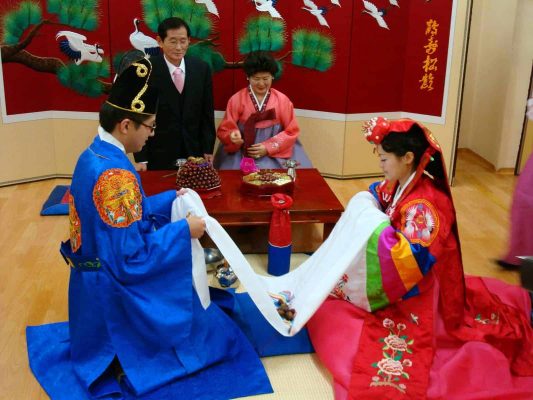

06 Korean Wedding Tradition style Jeonanyrye
This is known as the “presentation of the wild goose,” in which the groom traditionally gave a wild goose to his mother-in-law as a sign of his devotion to his future bride and to demonstrate that, like geese, who form lifelong bonds with their partners, he would be devoted to her for all time. Nowadays, the bride’s family will get wooden ducks as a present from the groom’s family.


07 Korean Wedding Tradition style Gyobaerye
The bride and groom would now meet for the first time because traditionally a Korean wedding was an arranged union. The bride and groom would then proceed to opposite sides of the wedding table, each with two attendants to help with the ritual, and the attendants would put out a rug for the bride and a rug for the husband. The bride and groom’s guests wash their hands to represent cleaning oneself before the wedding. The bride and groom bow to one another while facing each other: the bride twice to the groom, the groom once to the bride, the bride twice more, and finally the groom again. They bow to one another and get on their knees.
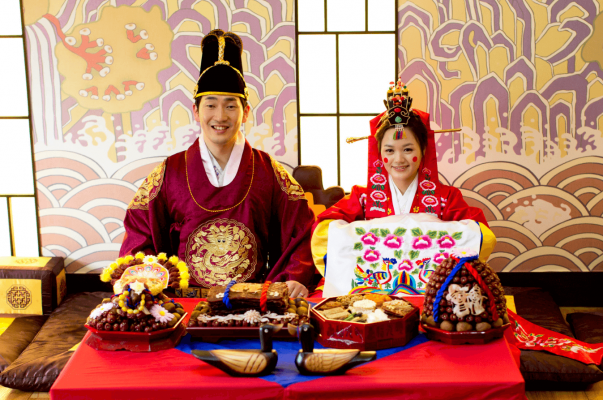

08 Korean Wedding Tradition style Hapgeunrye
At this point, the bride and groom will share a copper cup of alcohol. The bride and groom will either sip from a single cup, from two gourd halves linked by a thread, or from a mixture of both. The gourd’s halves represent how the bride and groom are uniting to form one whole being. According to one custom, the first drink from the copper cup symbolizes the couple’s bond. The gourd cups are used for the second taste and, to symbolize an exchange, are then passed back and forth between the bride and groom. Last but not least, the bride and groom bow together in homage to their parents, ancestors, and wedding guests.
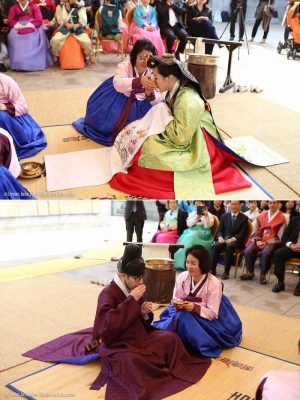

09 Korean Wedding Tradition style Paebaek
One of the most significant—and frequently the one that wedding guests enjoy the most—moments of the traditional Korean wedding emphasizes the value of family to Koreans. In the past, just the groom’s parents would attend the paebaek alongside the bride and groom, but nowadays both parents are invited.
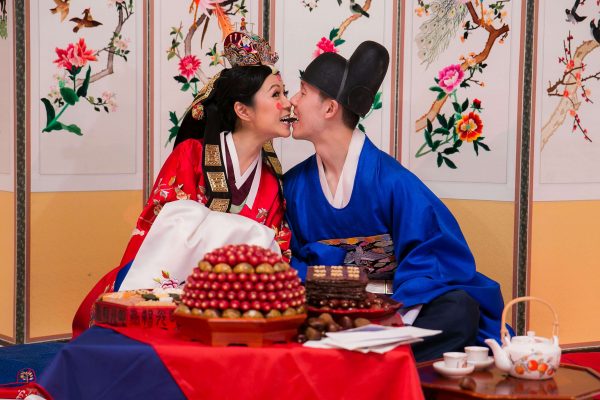

Previously, this ritual was reserved for certain family members. Still, nowadays, many modern couples arrange the ceremony during the reception’s cocktail hour so that all guests can see the paebaek and capture the event on camera. Behind a small table covered with food from the original wedding ceremony table, both sets of parents are seated. Traditionally, there were just three platters of food on the table: a tower of chestnuts and dates, flat beef jerky, and a third platter of eight little appetizers known as anju. Nowadays, families attempt to include as much food as possible on the table to make it appear as luxurious.
Paebaek meals are frequently made of plastic and are only offered for photos. After bowing and pouring tea, the pair enters. Their parents bestow blessings and financial gifts onto them. The couple makes a grand bow, a half bow, and then sits down. They catch dates and chestnuts that the two sets of parents toss while holding a white cloth with floral embroidery. The amount of dates and chestnuts the happy couple catches in the fabric is a proverbial representation of the number of children they will have, with dates standing in for males and chestnuts for girls.
The bride is then photographed, and the groom may or may not ride around the table on her back several times. The groom may also carry his mother and mother-in-law around the table if he feels up to it.
If you haven’t been to a Korean wedding yet, you might be surprised to learn that many popular traditions have evolved. From the ancient tradition of seungjangsaji to the modern tradition of kimchi beef, it’s easy to see that Korean weddings have a lot of history behind them.
Visit our website for more interesting posts, topics, information!

